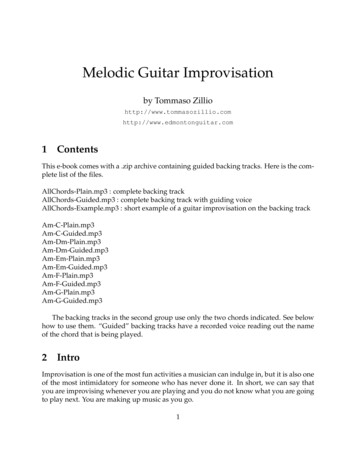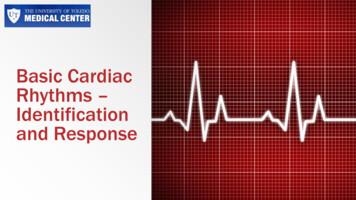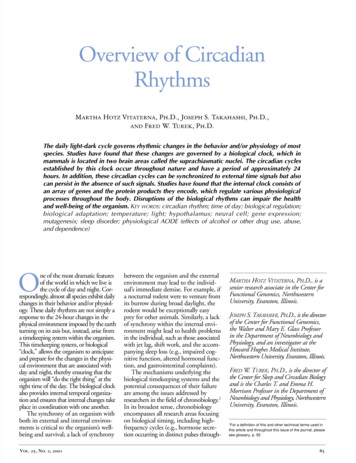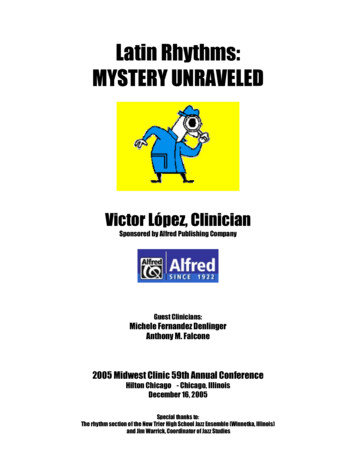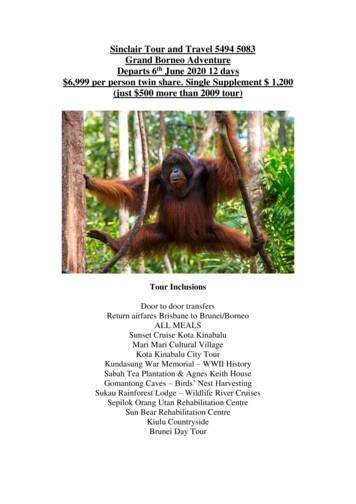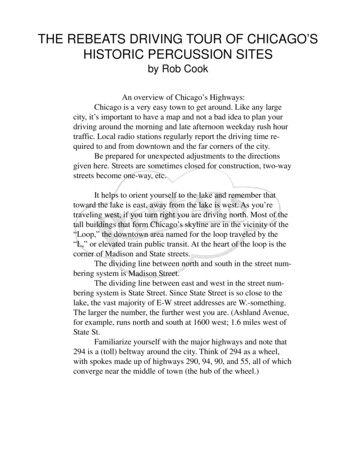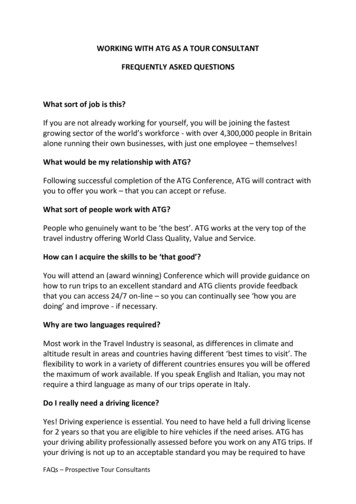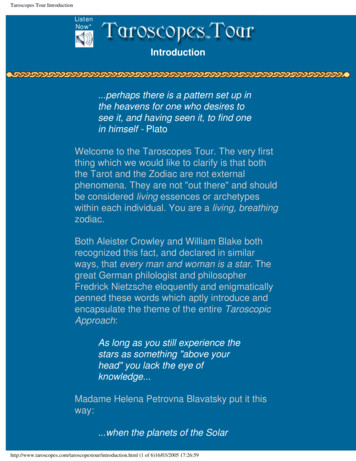
Transcription
Melodic rhythms byArafan TouréBackground
Published by Stichting De Overlevering in collaboration with Molenaar Edition BVCompiled by Astrid Lamein and Milou VelingDesigned by Saskia VolkerijkCover photo Arafan Touré by René DohmenPrinted by Elco ExtensionThe Netherlands, 2016All music may be practised using the accompanying CDs.
Melodic rhythms byArafan TouréContents11. Arafan Touré, ‘Docteur du Rythme’22. Notes on the Content43. Instruments and Music Notation64. The Rhythms95. CD - Ensemble and Instruction tracks136. CD - Musicians147. Acknowledgements15
1. Arafan Touré, ‘Docteur du Rythme’Arafan Touré was born in Conakry, the capital of Guinea, in 1937. His father was aMalinke, his mother a Susu. He grew up in the fishing quarter of Boulbinet, where heoften played percussion on tin cans with the neighbourhood children, imitating musicthey heard in Susu, Baga and Malinke ceremonies. From a very young age Arafandistinguished himself with his remarkable speed and dexterity on the djembe. Hequickly gained fame under the auspices of Vieux Coca Camara, playing with his musicand dance group ‘Djole Club’. With this group Arafan went on his first foreign tour tothe neighbouring Ivory Coast in 1957.In 1958 Guinea became independent from France and Sékou Touré proclaimedhimself President of ‘La République Populaire Révolutionnaire de Guinée’. He used therichness of Guinean culture to strengthen his power; he employed artists to promotehis policy. Each region had to form an ensemble and competitions were frequentlyorganised. All schools regularly had to arrange cultural activities involving traditionaldance and music.The best dancers from all regions, with different ethnic backgrounds were obligedto join ‘Les Ballets Africains de Guinée’ (hereafter termed: the Ballet) and wereinstructed to adapt their ritual music and dance to suit the international stage.The Ballet became the first national music and dance company based in Africa totravel worldwide, setting an example for other African national ballets. Much wasdemanded from the artists. For instance, they toured Mexico for 12 months and laterthe United States for two consecutive years.Arafan was also recruited for the Ballet, which allowed him greater access to thewealth of Guinean cultural traditions. He brought with him his knowledge of therhythms of Maritime Guinea, particularly Conakry, and within these rhythms he playedthe solo parts and signals for the dancers. He developed a technique for playingtwo djembes simultaneously. This way of playing can clearly be heard on the bonustrack on CD 1. Besides djembe, Arafan played dunduns, krin, calabash and siko (a flatsquare drum).For the staging of new performances the directors drew inspiration from aMandingue epic (e.g. Sundiata Keita), a ceremony (initiation, wedding etc.), or amoral theme. Each artist took part in the creative process. The musicians based theirorchestrations on songs or dance steps. The young Arafan could effortlessly recallmusic developed during rehearsals; he was not infrequently called ‘the Ballet’s musicalmemory’. During the tours, from Uganda to Cuba, he gathered useful elements thathe would later integrate into the Ballet’s compositions. Arafan served in the Ballet for26 years.2
Arafan came to the Netherlands in 1986 to work for Fatala, a Guinean group thatplayed both traditional and modern instruments. In 1988 they issued the album‘Gongoma Times’. In 1989 Arafan, with Fatala, contributed to Peter Gabriel’sbreakthrough world music album ‘Passion’.From 1991 Arafan’s career entered a new phase, when he became artistic leaderand soloist of Africa Soli, a traditional Guinean ensemble based in Nijmegen (NL).Arafan brought in artists from Guinea, created the programme and led therehearsals. The group released the CD ‘Salia’ (1992), later reissued as ‘Greetings fromGuinea’ (1998) and ‘Voices of Africa, vol. 3: Guinea’ (2007). In 2000 the Dutch radiostation ‘Concertzender’ produced the double CD ‘Arafan & Group’, recorded livein the Melkweg, Amsterdam. In 2003 Arafan worked together with Johan Aben onthe CD ‘Mixation’, on which Arafan’s djembe playing can be heard with electronicaccompaniment.During this period the djembe became very popular in the West. Arafan was adjembe master, with a unique sound on the djembe, and with extensive knowledgeand experience uncommon outside Africa. Because of these talents he wasapproached by both professional musicians and djembe fans for tuition. As a resulthe regularly gave workshops and weekly lessons in the Netherlands: in Amsterdam,Rotterdam, The Hague, Eindhoven and Arnhem. He also travelled to Ireland, France,Sweden and Argentina to give workshops. From 1993 he accompanied internationalstudy groups to Guinea.Arafan continuously developed his repertoire during his lessons, freely adaptingtraditional rhythms, separating remembered melodies into parts and re-orchestratingthem into the new, sometimes mixing in reggae and disco. During lessons he wouldoften spontaneously invent arrangements, which he encouraged pupils to record, inthis way preserving his innovations for future generations of djembe players.From the mid 90’s Arafan tried to spend a few months every year in Guinea. Heenvisioned the building of a music centre, posthumously realised in Hamdallaye,Conakry. Music Centre Arafan Touré offers facilities for local talent to be developedand is a place where foreign visitors can stay to study Guinean music.Arafan died in 2003, leaving his pupils more than 40 rhythm arrangements, of which20 are collected in this book.3
2. Notes on the ContentThis project’s aim is to record Arafan Touré’s musical heritage andpropagate it worldwide.After his death in 2003 some of Arafan’s Dutch students startedthis project. The sheet music is produced from collected material,consisting of lesson notes, recordings and memories. Supervisedby Sékou Touré, Arafan’s son, study and recording sessions wereorganised in Guinea to provide missing kenkeni, sangban anddundun parts. For this purpose percussionists from various balletsworked together.The CD recordingsThe accompanying CDs show how the rhythms may sound. Thefirst CD contains complete performances, the second CD containsinstruction tracks for each instrument.During his classes most rhythms were played at a slower pacethan the original Ballet’s tempo, Arafan believing that this betterexpressed the melodies. Sometimes he would demonstrate hisplaying speed in the Ballet, explaining: ‘Ça, c’est la danse, ici onjoue la musique’ (transl. ‘That’s dance, here we play music’).The music notationWestern music notation was used because of its universality,making the scores suitable for all kinds of instruments and foreducational purposes. Chapter 3 ‘Instruments and Music Notation’explains its application in the sheet music.In Western terminology, the rhythms in this book are either binaryor ternary in structure; in the music notation respectively 4/4 and12/8 time are used. Yankadi is originally known for its binary beat,in two’s, with a certain swing. However, a choice has been made touse a ternary notation, because it makes the music easier to readand it feels like a rhythm in three’s. In Concert de Tamtam, besidesthe metres 4/4 and 12/8, those of 3/4, 6/8 and 9/8 have been usedto aid the notation of some passages.Dunduns and djembesThe arrangements are performed by an ensemble consisting of akenkeni, a sangban, a dundun and several djembes. ‘Dunduns’ isa collective term referring to kenkeni, sangban and dundun (thelast one is also called ‘dundunba’). ‘Dundun part’ may refer to thedundun only, or to a combination of dunduns played by the sameperson.4
5
3. Instruments and Music NotationThis section explains the book’s use of classical music notation. For more detailedinformation regarding music notation we refer to the relevant published literature.The instrumentsdjembe: D1, D2, D3, D4,Solo and All ( all djembes together)kenkeni, sangban, dundun (kk, sb, dd)bell (attached to the kk, sb or dd, played with a metal rod or ring)Usually the sangban with bell is placed on top of the dundun.They are played together by one person, while someoneelse plays the kenkeni with bell.Exceptions:In Meni Rapide the sangban and kenkeni are standingupright and played together by one person with twosticks, while someone else plays the dundun with bell.In Kuku Cassé the kenkeni with bell is placed on top of thesangban. They are played together by one person, whilesomeone else plays the dundun with bell.In Concert de Tamtam the kenkeni, sangban and dundunare standing upright and played together by one personwith two sticks.Metres and countingThe rhythms are notated in 4/4 or 12/8 time according to their binary or ternarysubdivisions: counted in two’s or three’s. The 4/4 metre is counted ‘alla brève’ (halftime), with the beat on the first and third count of the bar. The 4/4 rhythms havetwo beats per bar, the 12/8 rhythms four beats.6
Staves the beatThree line staves have been chosen in the notation, each line representing a tonelevel. With the djembe the upper line is assigned to the slaps, the middle line tothe open tones and the lower line to the basses. With the dunduns the upper lineis assigned to the kenkeni, the middle line to the sangban and the lower line to thedundun. The bell has its own line.Note valuesIn order to make the scores easier to read, different note values have been used.This is not meant as an indication of differences in duration of the sound after theinstrument is struck.Handing on the djembeIn most rhythms and phrases thehands alternate, ghost notes included:The handing is only indicatedwhen this is not the case:‘R’ and ‘L’ apply to a right-handed player.Indication for a free solo7
single noteconnected noteduplet (2), triplet (3)restclosed slapmutedaccentuatedsofteron the DD, SB or KKthe stick is held againstthe drum for aninstantplayed a little louderthe smaller noteis played with lessemphasiscue, flamtext indicationsrehearsal marks11/23/81/41/81/16bellhigh-pitched slapsegno, go to segnoA8Bindicates where playis started againsignalshort recognizable phraseused to start, change orfinish the rhythmindicate identicalsectionsas often as desired oragreed uponflam: 2 strokes rapidlysuccessively played,one stroke each handall accompanyingparts together:the rhythmic basissections inConcert de Tamtam
4. The RhythmsConcert de TamtamDuring the Ballet tours in Africa the artists were encouraged to draw inspiration fromother cultures they encountered on the road. This resulted in new music and dancewhich was added to the repertoire. The original Concert de Tamtam was composedafter the 1974 African Tour and incorporated rhythms heard in Zaïre, Senegal andUganda. In Arafan’s version the three dunduns are played in a vertical position by oneperson with two sticks.BolonbaOriginally a Malinke rhythm from Mali. ‘Bolonba’ means ‘big bolon’, a three-stringedMalinke instrument played as bass. A well known bolon melody can be heard in thebasses of the first djembe part. On CD 1 the bolon plays an improvised melody.KallaMalinke rhythm from the Faranah Region, played at initiation ceremonies. The rhythmwas adopted by the Ballet from the Djoliba National Ballet. ‘Kalla’ means ‘stick’ inMalinke and is performed with the dancers bearing sticks. In the Ballet it was knownas the ‘Dance with the bows’.DjoleImported by fishermen from Sierra Leone, where the Temne people use a femalemask when performing Djole. They play the rhythm on sikos. In Conakry a Djole maybe organised for a feast, for fun or as a form of protest. Here, the sikos are joined bydunduns and djembes. Occasionally a female mask is used, in a tongue in cheek way.On CD 1 the second djembe part is played on kenkeni.Danse des Hommes FortsA composition based on the dundun part of the Dundunba rhythm, played forMalinke male dances in Upper Guinea.Kuku CasséThis radical reinterpretation of Kuku, originally a Konia rhythm from the border areabetween Guinea and Ivory Coast, was composed by Arafan whilst travelling by trainfrom Arnhem to Amsterdam. In Kuku Cassé, the kenkeni and sangban are placed ontop of one another and played together with a bell by one person, while someone elseplays the dundun with bell.PanthèreComposition consisting of two parts. Originally, part 1 was created for the Ballet bythe percussionist ‘Bunkia’ as requested by the dancer Jacoba ‘Chek’, who was inspiredby a dream in which he appeared as a panther. Part 2 was rearranged by Arafan,because it wasn’t being played to his satisfaction by his Dutch students.9
Panthère part 2 - Ballet versionDjembe accompaniments based on the original second part of the composition.The dundun part on CD 1 was improvised during the recording.MamayaMalinke rhythm from the Kankan Region, danced by large groups during celebrationssuch as the Feast of Sacrifice and the Sugar Feast, men and women dancing together,using the same gracious dance steps. In Guinea the balaphone plays an importantrole in Mamaya. The variations Arafan has created are to be used as solo elementsincorporated into the first djembe part.Meni Lent and Meni RapideMeni originates with the Temne people from Sierra Leone. In the Ballet, Meni wasplayed with repeating call and response phrases. Both Meni Lent and Meni Rapideare versions developed in the Netherlands by Arafan. Meni Lent is a good example ofhow he divided a melody amongst various djembes. In Meni Rapide the sangban andkenkeni are standing upright and are played by one person with two sticks.YokuiYokui is a spirit represented by a mask. Originally the dance Yokui is accompanied onBaga instruments. The rhythm is virtually identical to Guinée Faré, a Susu women’sdance.Sofa NouveauSofa is a Malinke rhythm. The traditional Sofa was danced by mounted warriors. ‘So’means ‘horse’. It is still performed for village chiefs and for important families andindividuals. Arafan created a new version, with a dundu
Handing on the djembe In most rhythms and phrases the hands alternate, ghost notes included: The handing is only indicated when this is not the case: ‘R’ and ‘L’ apply to a right-handed player. Indication for a free solo the beat 7. 1 1/2 3/8 1/4 1/8 1/16 bell single note closed slap segno, go to segno flam: 2 strokes rapidly successively played, one stroke each hand indicates where .
